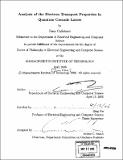| dc.contributor.advisor | Qing Hu. | en_US |
| dc.contributor.author | Callebaut, Hans, 1975- | en_US |
| dc.contributor.other | Massachusetts Institute of Technology. Dept. of Electrical Engineering and Computer Science. | en_US |
| dc.date.accessioned | 2007-07-18T13:05:17Z | |
| dc.date.available | 2007-07-18T13:05:17Z | |
| dc.date.copyright | 2006 | en_US |
| dc.date.issued | 2006 | en_US |
| dc.identifier.uri | http://hdl.handle.net/1721.1/37893 | |
| dc.description | Thesis (Ph. D.)--Massachusetts Institute of Technology, Dept. of Electrical Engineering and Computer Science, 2006. | en_US |
| dc.description | Includes bibliographical references (p. 187-193). | en_US |
| dc.description.abstract | Recently, the operating frequency range of quantum-cascade lasers (QCLs) has been extended from the mid-infrared to the far-infrared beow the Reststrahlen band (THz frequencies). Especially for THz QCLs, a detailed understanding of the dynamics of the electron transport is essential in order to extend their operation to longer wavelengths and higher temperatures. Compared to mid-infrared structures, the small subband separations in THz QCLs lead to LO-phonon scattering rates that are highly temperature sensitive and increases the importance of scattering processes which favor small transition energies, such as electron-electron (e-e), electron-impurity (e-imp)and electron-interface roughness scattering. This thesis details the development and calculation results for different models for the electron transport in THz QCLs. Using a semi-classical Monte Carlo simulation, including e-e and e-LO-phonon scattering as well as e-imp scattering, the current density, population density and gain in two THz QCLs were investigated. We find that the inclusion of e-imp scattering in the calculations is crucial when modeling the intersubband transport dynamics in these devices. However, the calculated gain and current density exceed the measured values due to the absence of wavefunction localization and dephasing scattering in this model. | en_US |
| dc.description.abstract | (cont.) To describe coherent electron transport, a density matrix (DM) approach in combination with a tight-binding model was incorporated into the Monte Carlo simulation. The scattering events were treated semi-classically but contributed to dephasing scattering. In addition, a phenomenological "dephasing rate" was introduced to take into account dephasing caused by interface roughness scattering. This model was used to investigate the influence of dephasing on transport through a barrier. Additionally, current densities, populations and electron temperatures were calculated for two quantum-cascade structures and compared to a semi-classical simulation. We find that the inclusion of coherent transport and dephasing in the calculations is essential when transport is dominated by transitions between weakly coupled states. As an alternative to the density matrix approach, a simulation based on the non-equilibrium Green's function formalism was implemented, based on the model described by Wacker [1]. We developed simulations which include momentum-dependent and momentum-independent scattering matrix elements. Scattering, including e-LO-phonon and e-imp scattering, is handled quantum-mechanically and takes into account the coherent interaction between states, as opposed to the semi-classical approach used in the DM picture. | en_US |
| dc.description.abstract | (cont.) A model was developed for e-e scattering, which produced thermalized subband electron distributions. In addition, several quantum-cascade devices were simulated and the calculation results were compared to the DM Monte Carlo results and measurements. We find that, while the NEGF simulations with momentum-dependent scattering matrix elements and e-e scattering predict the most accurate results, the simple NEGF simulation originally implemented by Wacker and the DM simulation can also yield acceptable results at a much reduced computational expense. | en_US |
| dc.description.statementofresponsibility | by Hans Callebaut. | en_US |
| dc.format.extent | 193 p. | en_US |
| dc.language.iso | eng | en_US |
| dc.publisher | Massachusetts Institute of Technology | en_US |
| dc.rights | M.I.T. theses are protected by copyright. They may be viewed from this source for any purpose, but reproduction or distribution in any format is prohibited without written permission. See provided URL for inquiries about permission. | en_US |
| dc.rights.uri | http://dspace.mit.edu/handle/1721.1/7582 | |
| dc.subject | Electrical Engineering and Computer Science. | en_US |
| dc.title | Analysis of the electron transport properties in quantum cascade lasers | en_US |
| dc.type | Thesis | en_US |
| dc.description.degree | Ph.D. | en_US |
| dc.contributor.department | Massachusetts Institute of Technology. Department of Electrical Engineering and Computer Science | |
| dc.identifier.oclc | 131401991 | en_US |
